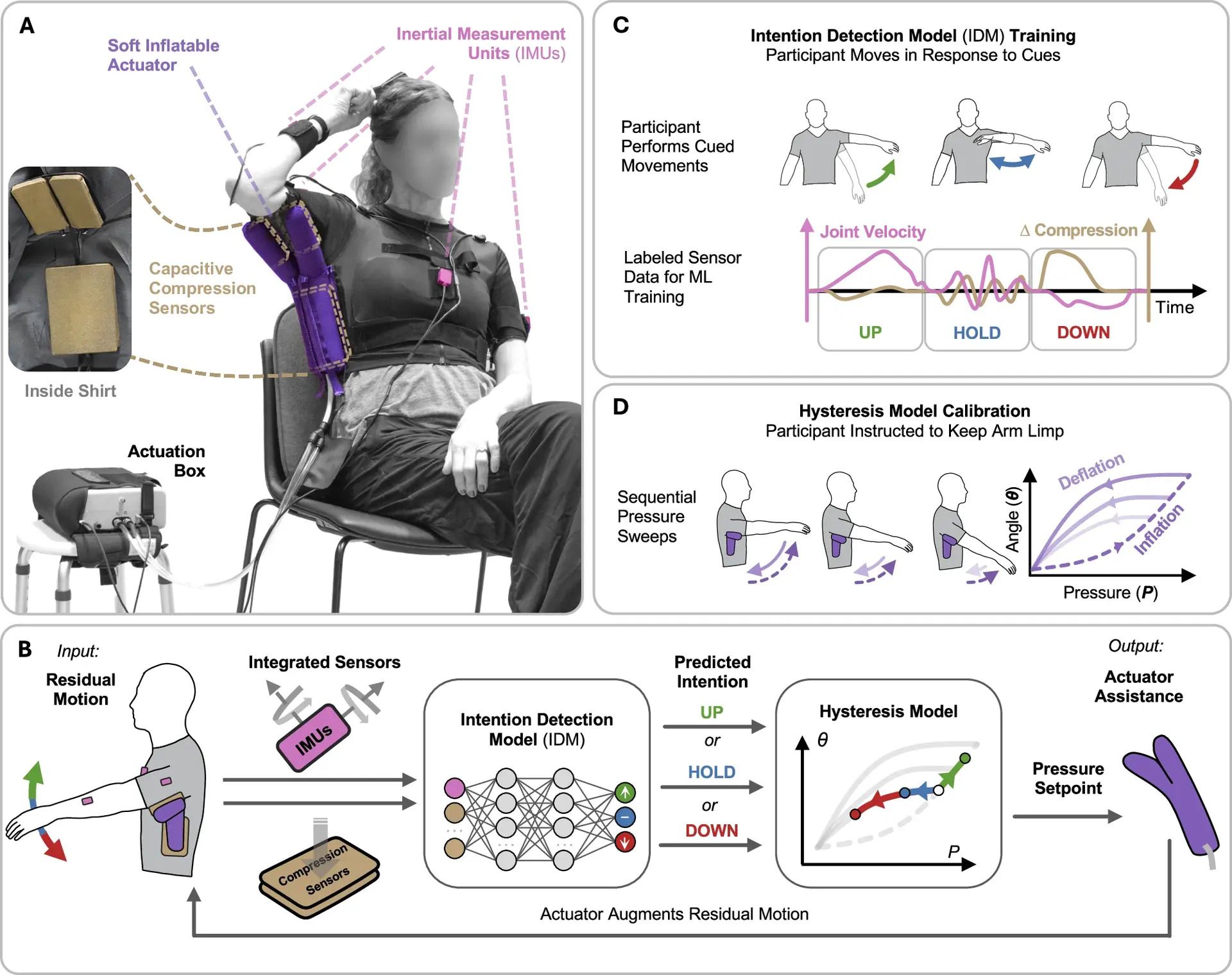Hi!
Welcome back to AIMedily. How is your week going?
People who work in health institutions have access to pretrained models, but not the public. In fact, very few clinics and private practices have integrated AI tools into their workflows.
Recently, Microsoft Copilot announced a collaboration with Harvard Medical School.
Their goal? To incorporate Harvard’s information into their AI LLMs so that users can get more accurate responses to their healthcare questions.
I would love to know if you use AI in your job, and which tools you use.
Now, let’s dive into today’s issue.
🤖 AIBytes
Researchers developed a machine learning (ML)–based controller for a soft, inflatable shoulder exosuit that personalizes assistance for stroke or amyotrophic lateral sclerosis (ALS) patients.
The system decodes the user’s movement intentions and adjusts support.
🔬 Methods
Participants: 9 individuals (5 post-stroke, 4 with ALS).
The participants performed joint movements and functional tasks (e.g., brushing teeth, drinking) with and without robotic assistance.
Inflatable soft shoulder wearable with IMU (inertial measurement unit) and soft compression sensors.
Control system:
Intention Detection Model (IDM) trained to recognize UP, HOLD, and DOWN movements using sensor data.
Hysteresis model estimated the minimum pressure needed to support the arm.
Both models were integrated into a controller that predicted intention and adjusted pressure.
📊 Results
Intention detection accuracy: 94.2 %
Effort reduction: 31.9% less force required to lower the arm (p = 0.008).
Range of motion (ROM):
Shoulder: + 17.5°
Elbow: + 10.6°
Wrist: + 7.6°
Trunk compensation: −25.4%.
Hand path efficiency: +53.8% improvement.

🔑 Key Takeaways
The controllers can accurately predict movement intention and adjust robotic assistance in real time.
The robot improved multi-joint coordination, reduced compensatory trunk motion, and enhanced hand path efficiency.
Portable, soft, and adaptive designs that have the potential to be used at home.
🔗 Arnold J, Pathak P, Jin Y, et al. Personalized ML-based wearable robot control improves impaired arm function. Nature Communications. 2025;16:7091. doi:10.1038/s41467-025-62538-8
This study compared how general open LLMs like ChatGPT-4o, Gemini 2.5 Flash, and Claude Opus 4 interpreted and answered regenerative-medicine guidelines for chronic pain.
🔬 Methods
Cross-sectional evaluation using 16 open-ended questions based on the American Society of Pain and Neuroscience’s (ASPN) regenerative-therapy guidelines.
Models tested:
Who evaluated? Two PM&R physicians rated each response for accuracy (1–5), reliability and usefulness (1–7), readability (Flesch-Kincaid scores), semantic similarity (Universal Sentence Encoder), and hallucination rate (Reference Hallucination Score).
📊 Results
Reliability: Claude 4 (5.19) > ChatGPT-4o (4.13) and Gemini 2.5 (4.19).
Usefulness: Claude 4 (5.06) > ChatGPT (3.94) and Gemini (4.06).
Clinical accuracy: Claude 4 (4.06) > ChatGPT (3.38) and Gemini (3.38).
Semantic similarity to guidelines: Claude 4 (0.68) and Gemini (0.65) > ChatGPT (0.60).
Hallucinated references: Claude 4 (4.44), half of ChatGPT (8.38) and Gemini (8.75).
Readability: Comparable across models.
🔑 Key Takeaways
Claude 4 generated the most accurate, reliable, and clinically useful responses.
It produced significantly fewer hallucinated citations than ChatGPT and Gemini.
All models showed similar readability, but Claude aligned better with official guidelines.
Evaluating LLMs against real clinical evidence is essential before adoption in regenerative medicine.
🔗 Kuculmez O, Usen A, Dündar Ahi E. Referential hallucination and clinical reliability in large language models: a comparative analysis using regenerative medicine guidelines for chronic pain. Rheumatology International.2025;45:240. doi:10.1007/s00296-025-05996-z
🦾TechTool
A tool that converts written text into natural-sounding speech — useful for creating voiceovers or educational materials.
Useful for medical education, accessibility, and rehabilitation voice training.
Supports over 70 languages.
Not HIPAA-compliant, so it should never handle patient data or clinical notes.
Virtual Reality for telerehabilitation, allowing exercise at home or in the clinic.
Uses a wireless headset with therapy in a game format for upper limb and cognitive rehabilitation.
You can customise exercises, monitor progress, view analytics, and communicate with patients remotely.
Certified as a Class I medical device in the EU.
A free AI assistant that summarizes articles, PDFs, and web content directly in the browser—helpful for rapid literature review.
Integrates with email, note-taking, and messaging tools.
Multilingual, allowing for quick translation and summarization.
Remembers prior prompts within a document or webpage.
🧬AIMedily Snaps
🧩TriviaRX
What year did the term “artificial intelligence” first appear in scientific literature?
A) 1943
B) 1956
C) 1969
D) 1975
✅ D) 2016 — The EksoGT exoskeleton by Ekso Bionics was the first FDA-cleared robotic exoskeleton for both stroke and SCI rehabilitation.
That’s it for today.
As always, thank you for taking the time to read.
Every share helps build a community that keeps AI in healthcare transparent, accurate, and human-centered. If you know someone who’d appreciate that, send them to AIMedily.
Thank you!
See you Friday.
Itzel Fer, MD PM&R
Join my Newsletter 👉 AIMedily.com
Forwarded this email? Sign up here
P.S. I’d love to hear from you! Even a single sentence makes a big difference. It only takes 30 seconds ⏰ Write a review here







